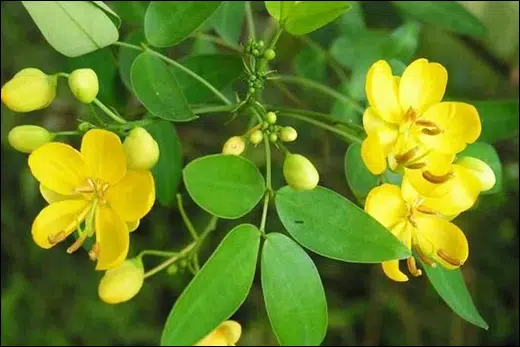Chakramarda / Sickle Senna / Cassia tora – Classification, Ayurvedic Properties & Dosage
Description
Chakramarda is a well known wild herb which is known for its medical attributes in Asian countries. In Ayurveda this plant constitutes as “Dadrugani vati” which is useful in the treatment of various kinds of Skin Diseases such as ringworm infection, skin infection, leucoderma, pain, leprosy and allied skin disorders. In modern science, various ethnomedicinal properties such as Antioxidant, antimicrobial, anti diabetic, anti inflammatory, hypolipidemic, immunostimulatory, anti tumour, hepatoprotective, oxytocic are discovered and many more are in queue.

Synonyms
- Andagaja
- Gajakhya
- Edagaja
- Cakri
- Punnada
- Tarvata
- Mesahvaya
Other Vernacular Names
- In Hindi – Cakavada, Pavanda
- In English – Sickle senna, Ring-worm plant, coffee pod, foetid cassia
- In Malaysia – Bunga siam
- In Gujarati – Kuvadio
- In Bengali – Cavuka
- In Tamil – Tagharai
- In Telugu – Tantemu
- In French – Gomme de cassia
Taxonomical Classification
- Kingdom – Plantae
- Order – Fabales
- Family – Fabaceae
- Genus – Cassia
- Species – C.tora linn.
- Phylum – Spermatophyta
- Class – Magnoliopsida
Habitat
Chakramarda is an annual shrub that grows all over the tropical areas. It is a common rain weed, especially in waste places, roadsides, forest edges etc. It is generally found in warm places. The plant grows as a weed in the Himalayan regions up to 1450m. It is found in the plains of UP, Bihar, Rajasthan, Orisa, Maharashtra, Bengal, Punjab and Tamil Nadu.
Morphology
Chakramarda is a short, erect, smooth, semi woody, annual herb, 1-2 metres tall. Leaves are 6.0- 12.5 cm long, leaves in pairs of 3, membranous, ovate, subordinate glands on the last two pairs, showing sleepy movements at night. Flowers are bright yellow coloured usually in pairs. Pods are thick 4 angled, 15-25 cm long. Seeds are green, rhombohedral in shape.
Chemical Composition
Irimeda has various phytochemicals due to these compounds, it shows a variety of pharmacognostic activities. These are:
| Part of the Plant | Phytonutrients | Properties |
| Leaves | Myricyl alcohol, glycosides, mannitol, flavonoids. Emodin, stigmasterol, friendlen, palmitic, stearic, succinic acid and tartaric acid, Kaempferol etc. | Anti diabetic, Anti microbial, Anthelmintic. Anti inflammatory, Anti proliferative. |
| Roots | Anthraquinone, Emodin, beta-sitosterol, choline, Rudrofusrain, chrysophanic acid. | Anti tumour, anti oxidant. |
| Seeds | Emodin, subrofusarin, chryophanic acid, rubro-fusarin, quercetn, phenolic glycoside, gentiobioside, tri glucoside and torachrysone etc. | Hypolipidemic, Antiulcer, hepatoprotective, Anti mutagenic, oxytocic, Anti diabetic. |
Classical Categorisation
Chakramarda is the one of the most important plants vividly described in the Ayurvedas in almost every nighantu due to its medicinal properties. These classical contexts are following:
- Bhavaprakash nighantu / Hareetakyadi varga
- Raj nighantu / Satahvadi varga
- Kaiyadeva nighantu / Aushadi varga
- Dhanvantari nighantu / Karaveeradi varga
- Charaka / Shaka varga
Ancient Verse
Shloka – 1
चक्रमर्दः प्रपुन्नाटो दद्रुघ्नो मेषलोचनः |
पद्माटः स्यादेडगजश्चक्री पुन्नाट इत्यपि ||
चक्रमर्दो लघुः स्वादू रूक्षः पित्तानिलापहः |
हृद्यो हिमः कफश्वासकुष्ठदद्रुकृमीन्हरेत् ||
हन्त्युष्णं तत्फलं कुष्ठकण्डूदद्रुविषानिलान् |
गुल्मकासक्रिमिश्वासनाशनं कटुकं स्मृतम् ||
Reference – Bhavaprakash nighantu / haritakyadi varga / shloka 210-212
Interpretation of Shloka – Firstly, this shloka explains the synonyms of chakramarda such as Punnata, Dadrughna, Mesahvaya, Edagaja, Cakri, and Punnada. This shlokas also describes the various properties such as light to digest (laghu), sweet (svadu), dry (rooksha), balances fire and air elements of the body (pittanilahara), act as cardiac tonic (hrudya hitkari), decreases kapha. It is used for the treatment of asthma and chronic respiratory disorders (shwasa), skin diseases (Kushta), worm infection (krimi), ringworm infection (dadru).
Shloka – 2
चक्रमर्दः कटुस्तीव्रो मेदोवातकफापहः |
व्रणकण्डूतिकुष्ठार्तिदद्रुपामादिदोषनुत् ||२००||
Reference – Raj nighantu / Satahvadi varga/ shloka 200
Interpretation of Shloka – In this shloka various medicinal properties of chakramada are explained as it helps to treat skin infections, leprosy, ulcers and pain. It also helps in wound healing.
Ayurvedic Properties
- Rasa (Taste) – Katu (pungent)
- Guna (Properties) – Laghu (light to digest) and Rooksha (dry)
- Vipaka – Katu (pungent after digestion)
- Veerya (Potency) – Ushna (hot)
Chakramarda is widely used to treat vitiated tridoshas.
Practical Uses
Chakramarda shows tremendous applications in both traditional and modern medical systems. These are some applications given below:
- External application of chakramarda, sarjarasa, etc mixed with sour gurl is a remedy for Sidma type of Kushta.
- The root of chakramarda is grounded finely and put into vagina. It helps easy delivery.
- Fresh leaves pounded with alcohol and vinegar are applied externally to treat eczema and psoriasis.
- Water decoction of the leaves of the Chakramarda used for the treatment of fever.
- Seeds of chakramarda contain anthrax glucoside that gives a laxative effect.
- Chakramarda seeds help in digestion by removing toxins from the body.
- Leaves are pounded and are applied topically in case of the bee sting.
- Paste seeds and radish leaves are used for the treatment of ringworm infection.
- In Korea, hot extract of seeds are used to treat liver disease.
- In Chinese medicine, the seeds are used as antiasthenic, diuretic, antihypersensitive, and ocular activities.
Part Used
Seeds, leaves, roots
Dosage
- Seed Powder : 1-3 gm
- Leaf Juice : 5-10 ml
Ayurvedic Products
There are various classical formulations prepared from chakramarda such as:
- Dadrugani Vati
- Edagajadi Lepa
- Chakramarda Tailam


